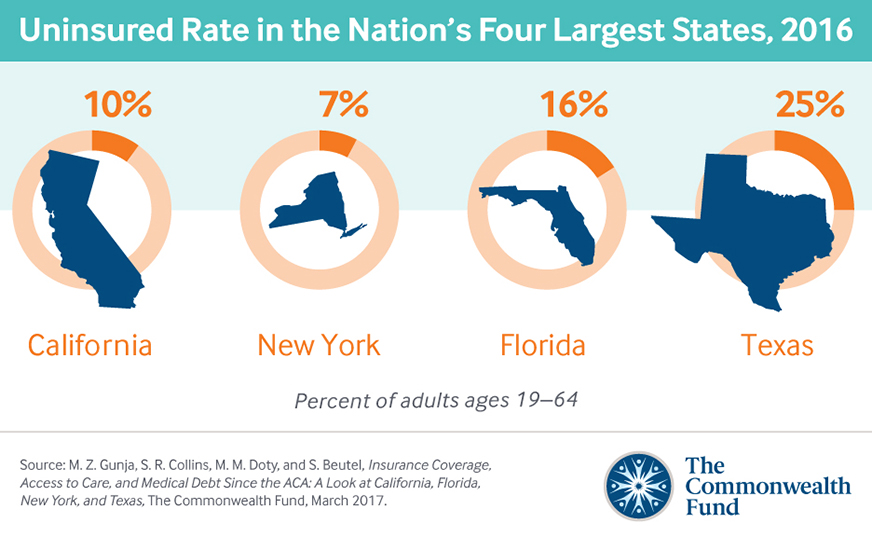New York, NY, March 22, 2017—After the Affordable Care Act’s (ACA) coverage expansions, people in California and New York—states that expanded Medicaid and created their own health insurance marketplaces—were less likely than people in Florida and Texas to have medical bill problems, more likely to be insured, and better able to afford the health care they needed. The findings are from Insurance Coverage, Access to Care, and Medical Debt Since the ACA: A Look at California, Florida, New York, and Texas, a Commonwealth Fund report out today that compares the health insurance coverage, access, and medical debt experiences of people in California, New York, Florida, and Texas—the nation’s four largest states.
“The striking differences among our biggest states demonstrates how much state health policy decisions affect residents,” said Sara Collins, Vice President for Health Care Coverage and Access at The Commonwealth Fund and coauthor of the report. “Where you live can determine whether or not you have health insurance, if you can afford your medication, and if you can get the health care you need when you’re sick.”

The report compared people’s experiences in 2016 in several areas:
- Medical bill problems. Forty-one percent of Floridians and 44 percent of Texans reported they had trouble paying or were unable to pay medical bills in the past year, were contacted by a collection agency about unpaid medical bills, had to change their way of life to pay them, or were carrying medical debt. In contrast, 28 percent of people in California and New York reported any of these medical bill or debt problems.
- Affording health care. Forty-one percent of Floridians and 45 percent of Texans reported that, in the past year, they had been unable to afford a doctors’ visit when they had a medical problem or were unable to pay for a prescription, specialty care, a recommended test or treatment, or follow-up care. Twenty-eight percent of Californians and 29 percent of New Yorkers reported experiencing these affordability problems. Notably, how much people with coverage had to pay when they got sick also varied: a significantly smaller share of insured New York and California residents (8% and 13%, respectively) had large deductibles—5 percent or more of income—compared with Texas (17%) or Florida residents (19%).
- Young adults and people with low incomes fared better in California and New York. Eight percent of young adults were uninsured in California and 10 percent were uninsured in New York, compared to 23 percent in Florida and 30 percent in Texas. Nine percent of adults with incomes below 100 percent of the federal poverty level—$11,880 for an individual or $24,300 for a family of four—were uninsured in California and 15 percent were uninsured in New York. This compares with 22 percent in Florida and 39 percent in Texas.
“This report shows that when states embrace policies that make health care and health insurance affordable and accessible, people benefit,” said Commonwealth Fund President David Blumenthal, M.D. “As the Affordable Care Act and Medicaid face an uncertain future, states should take whatever steps they can to hold onto the progress they have made under the ACA and ensure people can get the health care they need.”
Moving Forward
The Affordable Care Act’s health insurance expansions have been critical to helping people get and afford the health care they need. However, the authors note it is also important for health insurance plans to be comprehensive and cover the services people need, with deductibles and out-of-pocket expenses they can afford. Any proposal to repeal or replace the ACA, they say, should further expand health insurance coverage and continue to make health care affordable for people in every state.
|
Methodology The Commonwealth Fund Biennial Health Insurance Survey, 2016, was conducted by Princeton Survey Research Associates International, with a random nationally representative sample of nonelderly adults collected from July 12, 2016, to November 20, 2016, and an oversampling of adults in the four largest states, California, Florida, New York, and Texas. The survey consisted of 25-minute telephone interviews in either English or Spanish with adults age 19 and older living in the continental United States. A combination of landline and cellular phone random-digit-dial samples was used to reach people. The study was designed to generalize to the U.S. adult population and to allow for separate analyses of responses of low-income households as well as adults in the four largest states. Most of this analysis looks at adults ages 19 to 64 in the four largest states. The sample sizes are: California=716, Florida=663, New York=739, and Texas=699. Statistical results are weighted to correct for the stratified sample design, the overlapping landline and cellular phone sample frames, and disproportionate nonresponse that might bias results. Each state sample is weighted to match population parameters for sex by age, sex by education, age by education, race/ethnicity, population density, household telephone use, household size, and region, using the U.S. Census Bureau’s 2016 American Community Survey data. The resulting weighted national sample is representative of the approximately 187.4 million U.S. adults ages 19 to 64 and has an overall margin of sampling error of +/– 1.9 percentage points at the 95 percent confidence level. The California sample has a margin of error of +/– 4.2 percentage points at the 95 percent confidence level; the Florida sample margin of sampling error is +/– 3.7 percentage points; the New York sample margin of sampling error is +/– 3.8 percentage points; and the Texas sample margin of sampling error is +/– 3.8 percentage points. The landline portion of the survey achieved a 10 percent response rate and the cellular phone component achieved an 8 percent response rate. |